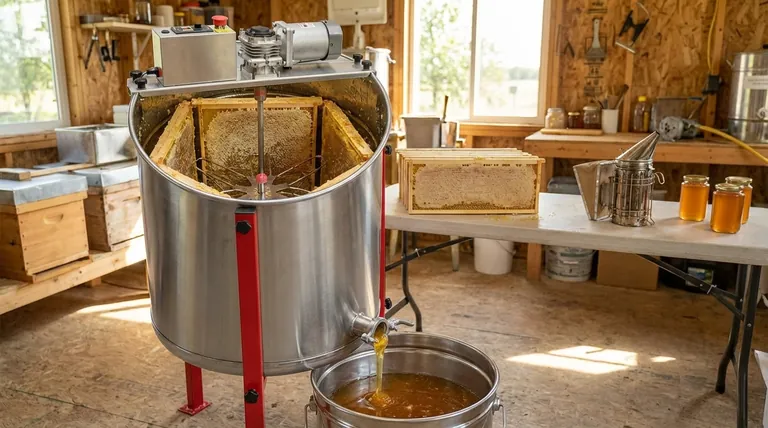The primary purpose of a honey extractor is to remove honey from the honeycomb frames using centrifugal force. This method is highly efficient and, crucially, allows for the removal of honey without destroying the delicate wax comb, which can then be returned to the hive for the bees to refill.
The core problem with older honey harvesting methods was the destruction of the honeycomb. A honey extractor solves this by preserving the comb, saving the bees immense energy and resources they would otherwise spend rebuilding it from scratch.

How an Extractor Works: The Power of Centrifugal Force
A honey extractor operates on a simple yet effective principle, much like a salad spinner or the spin cycle on a washing machine. The process is straightforward and is designed to be both fast and gentle.
The Basic Mechanics
An extractor is essentially a large, cylindrical drum. Inside, a central basket or rack is designed to hold the frames of honey.
Once the frames are loaded, this central fitting is rotated at high speed. The resulting centrifugal force flings the liquid honey out of the uncapped honeycomb cells and onto the inner walls of the drum.
Gravity then pulls the collected honey down to the sloped bottom of the drum, where it pools and can be drained through a tap, ready for bottling.
The Importance of Uncapped Honey
For the process to work, beekeepers must first slice off the thin layer of wax, known as "cappings," that bees use to seal the honeycomb cells. The extractor can only sling honey out of these uncapped cells.
Why Preserving the Comb Matters
The single greatest advantage of using an extractor is the preservation of the comb. Bees expend a tremendous amount of energy producing wax and constructing the comb's intricate hexagonal structure.
By returning the empty, intact frames to the hive, the beekeeper gives the colony a massive head start. The bees can immediately begin refilling the cells rather than spending weeks rebuilding the entire foundation.
Manual vs. Electric: Choosing the Right Tool
The fundamental difference between extractor types lies in how the spinning motion is powered. This choice directly relates to the scale of the beekeeping operation.
The Manual Extractor
Manual extractors use a hand crank to rotate the internal basket. These are often tangential extractors, which hold a smaller number of frames (typically 2-6) and are ideal for hobbyists.
They are simple, effective for small batches, and represent a lower initial investment.
The Electric (Motorized) Extractor
Motorized extractors use an electric motor to power the spinning mechanism, eliminating the need for manual labor. This dramatically increases speed and efficiency.
These machines are favored by beekeepers with more than a few hives and are essential for commercial operations. They can process a much greater number of frames at once, with industrial models handling over 100 frames simultaneously.
Understanding the Trade-offs
Choosing an extractor requires balancing cost against the needs of your operation. The decision hinges on scale, labor, and budget.
Scale and Investment
Manual extractors are the entry-level tool for small-scale beekeepers. They are cost-effective but limited in capacity.
Electric extractors require a higher investment but provide the efficiency needed for growing operations. Large-scale commercial extractors are a significant capital expense, suitable only for industrial beekeeping with 200 or more colonies.
Labor vs. Efficiency
The primary trade-off is between physical effort and speed. A manual crank is labor-intensive and time-consuming, while a motor automates the hardest part of the job.
An electric extractor can process large amounts of honey quickly, saving valuable time and reducing physical strain during the busy harvest season.
The Advantage of Speed Control
Many electric models offer the ability to control the spinning speed. This is a critical feature that helps prevent "blowing out" or destroying the comb, especially with new or delicate frames. Starting slow and gradually increasing speed minimizes damage.
Making the Right Choice for Your Goal
Your choice of extractor should align directly with the scale and ambition of your beekeeping.
- If your primary focus is hobby beekeeping (1-3 hives): A simple manual extractor is the most practical and cost-effective solution for your needs.
- If your primary focus is a growing sideline (5+ hives): An electric extractor is a worthwhile investment that will save you significant time and labor.
- If your primary focus is a commercial operation: A high-capacity, motorized commercial extractor is an essential piece of equipment for industrial-level efficiency.
Ultimately, the honey extractor is the tool that enables a sustainable and productive harvest for both the beekeeper and the bees.
Summary Table:
| Extractor Type | Best For | Key Feature |
|---|---|---|
| Manual | Hobbyists (1-3 hives) | Cost-effective, hand-crank operation |
| Electric | Sideline/Growing Operations (5+ hives) | Motorized for speed and labor savings |
| Commercial | Large-Scale Apiaries (200+ colonies) | High-capacity, industrial-grade efficiency |
Ready to scale your honey harvest? As a leading wholesale supplier to commercial apiaries and distributors, HONESTBEE provides the durable, high-performance extractors your operation needs to maximize yield and protect your valuable honeycomb. Let's discuss the right equipment for your scale. Contact our experts today for a quote!
Visual Guide

Related Products
- Electric 8 Frame Honey Spinner Extractor Equipment for Beekeeping
- HONESTBEE 72 Frame Industrial Electric Honey Extractor for Beekeeping
- HONESTBEE 3-Frame Manual Acrylic Honey Extractor
- 2 Frame Stainless Steel Manual Honey Spinner Extractor for Beekeeping
- 8-Frame Electric Self-Reversing Honey Extractor Spinner for Commercial Honey Extraction Equipment
People Also Ask
- What machines are needed in beekeeping besides basic tools? Scale Your Honey Harvest Efficiently
- Why is cleaning a honey extractor important in beekeeping? Protect Your Honey Quality & Equipment
- How long should you spin honey for? Master the Art of Efficient, Safe Extraction
- What should be considered when harvesting honey from multiple hives? Scale Your Harvest Efficiently
- How long should you spin honey? Master the Art of Efficient, Damage-Free Extraction



















